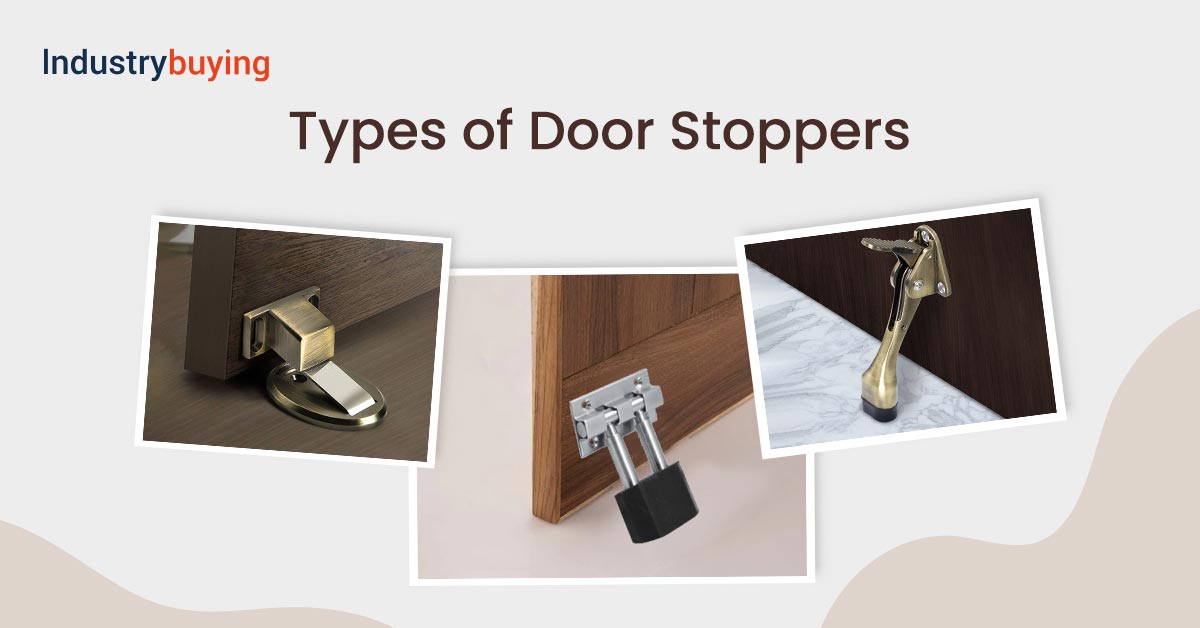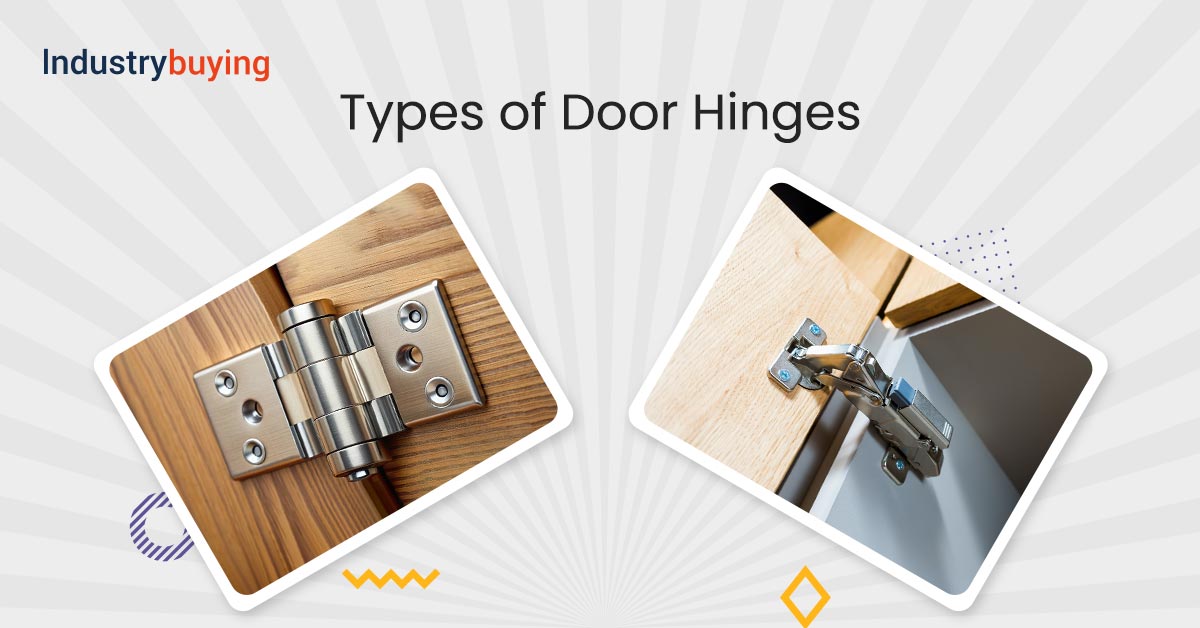Different Types of Door Stoppers and Their Features

Last Updated on October 23, 2024
Door stoppers are items that prevent doors and gate handles from causing any damage to the wall. They are also known as bumpers. The wall behind the door is prone to damage without door stoppers. Many a time, these stoppers also help prevent damage to the cabinet, countertop, or furniture. Proper applications help to avoid the need to re-plaster. Different types of door stoppers are used for residential, commercial, and official settings.
Types of Door Stoppers
There are various types of door stoppers available in the market today; therefore, it becomes essential to understand the difference between them. Let us have a look:
- Baseboard Door Stoppers
- Floor Door Stoppers
- Hinge Door Stoppers
- Wall Door Stoppers
- Hook Door Stoppers
- Kickdown Door Stoppers
1. Baseboard Door Stopper
They are the most common type of door stoppers and are used for doors that open or close parallel to the wall, where there is a baseboard at the bottom of the wall. There are two types of baseboard door stoppers- solid baseboard door stoppers and spring baseboard door stoppers.
Features of Spring Baseboard Door Steps:
- They are not expensive
- They are easy to install
Features of Solid Baseboard Door Steps:
- They are more expensive than spring baseboard doorsteps
- They are used with heavy doors
2. Floor Door Stopper
These stoppers are on the floor instead of the door and help prevent the gates from damaging the wall. They do not allow the gate to open too wide. They are made of small metal arches and come in two sizes: “half-dome” and “goose-neck.”
Features of Floor Door Stoppers:
- Durability: Floor door stoppers are made up of strong materials like zinc and steel and thus are durable.
- Non-Slip Base: Non-slip base ensures that the stopper does not slip.
- Impact Absorption: The presence of a soft rubber tip ensures that no harm is inflicted on the walls around the doors.
- Compact Design: Floor door stoppers have a compact design, which helps in the unobtrusive opening and closing of the door.
- Easy to Install: These stoppers are easy to install making them ideal for both residential and commercial uses.
3. Hinge Door Stoppers
Hinge door stoppers are directly attached to the door’s hinge, preventing the door from opening to either side and causing damage to nearby walls or furniture. They limit the movement of doors.
Features of Hinge Door Stoppers:
- Adjustable: Many hinge door stoppers come with adjustable arms or rubber bumpers, which allow you to set how far the door can open before the stopper starts to function.
- Easy Installation: Hinge door stoppers are easy to install.
- Shock Absorption: Hinge door stoppers have rubber tips that absorb the shock when the door is opened too far.
- Durability: Hinge door stoppers are durable as they are made up of materials like zinc and steel.
4. Wall Door Stoppers
Wall door stoppers are highly popular for commercial uses. They are installed directly on the walls where the door knob would inflict damage. This makes them the most visible of all door stops.
Features of Wall Door Stoppers:
- Compact Design: Wall door stoppers are available in a compact design, proving an aesthetic appeal.
- Various Shapes: These stoppers are available in a variety of shapes giving choice to the user.
- Multiple Mounting Options: These stoppers can either be screwed into the wall for a permanent installation or can be attached with an adhesive.
- Rubber Cushion: The presence of rubber cushions helps absorb any shock.
5. Hook Door Stoppers
As the name suggests, hook door stoppers come with a hook mechanism that helps hold the door in place. This makes them a common choice for both residential and commercial applications.
Features of Hook Door Stoppers:
- Double Functionality: Hook door stoppers help prevent the door from banging and inflicting damage to the walls and furniture. They also help hold the security in one position.
- Versatile Design: These stoppers can be used on various surfaces, including wood, tile, concrete, etc.
- Compact Design: The compact design of hook door stoppers helps save space.
6. Kickdown Door Stoppers
Kickdown door stoppers function when they are kicked down with the foot. They are kicked up when not in use which in turn allows the door to move freely. They are convenient to use and follow a simple mechanism, which makes them a popular choice for residential and commercial use.
Features of Kickdown Door Stoppers:
- Foot-Operated: Since the kick-down door stoppers function only when kicked up or down, they have a simple mechanism, making them easy to operate.
- Durable Materials: Since these stoppers are made of sturdy materials like stainless steel and aluminium, they are capable of holding heavy doors.
- Non-Slip Rubber Tip: The bottom of the stopper comes with a rubber tip or pad to provide a firm grip on the floor and prevent slipping. The rubber also helps prevent damage to the flooring and reduces noise when the stopper is engaged.
- Weather-Resistant: Some kick-down stoppers designed for outdoor or industrial use are weather-resistant and can withstand exposure to elements, making them ideal for exterior doors, garages, or commercial spaces.
7. Glass Door Stoppers
Glassdoor stoppers protect doors made of glass from damage by stopping them from hitting walls, furniture, and doors. Since these doors are made of glass, they are prone to damage all the time. For the same reason, these stoppers are made up of softer materials and provide a safe solution.
Features of Glass Door Stoppers:
- Non-Slip Base: Glass door stoppers have non-slip bases and ensure that the doors stay securely at one place.
- Floor or Wall Mounted: These stoppers can either be floor-mounted (placed near the edge of the door) or wall-mounted (positioned where the door may come into contact with the wall). Wall-mounted models often have softer cushioning to avoid damaging the glass.
- Magnetic Options: Glass doors often come with a magnetic mechanism which helps them stay at one place when they are fully opened or closed.
Conclusion
- Door stoppers provide long-term protection to the walls and furniture.
- When investing in door stoppers, you should consider whether you want them for residential, official, or commercial spaces.
- Ensure that the stoppers are properly installed. Frequent repairs and replacements can be avoided by proper installation.
FAQ’s
Different types of door stoppers are baseboard door stoppers, floor door stoppers, hinge door stoppers, wall door stoppers, hook door stoppers, and kick-down door stoppers.
Door stoppers are commonly made of zinc, steel alloys, and other sturdy materials that provide them durability and longevity.
Door Stoppers are important for providing safety, protection, convenience, noise reduction, energy efficiency, and aesthetics. They play a significant role in holding doors securely in one place.

